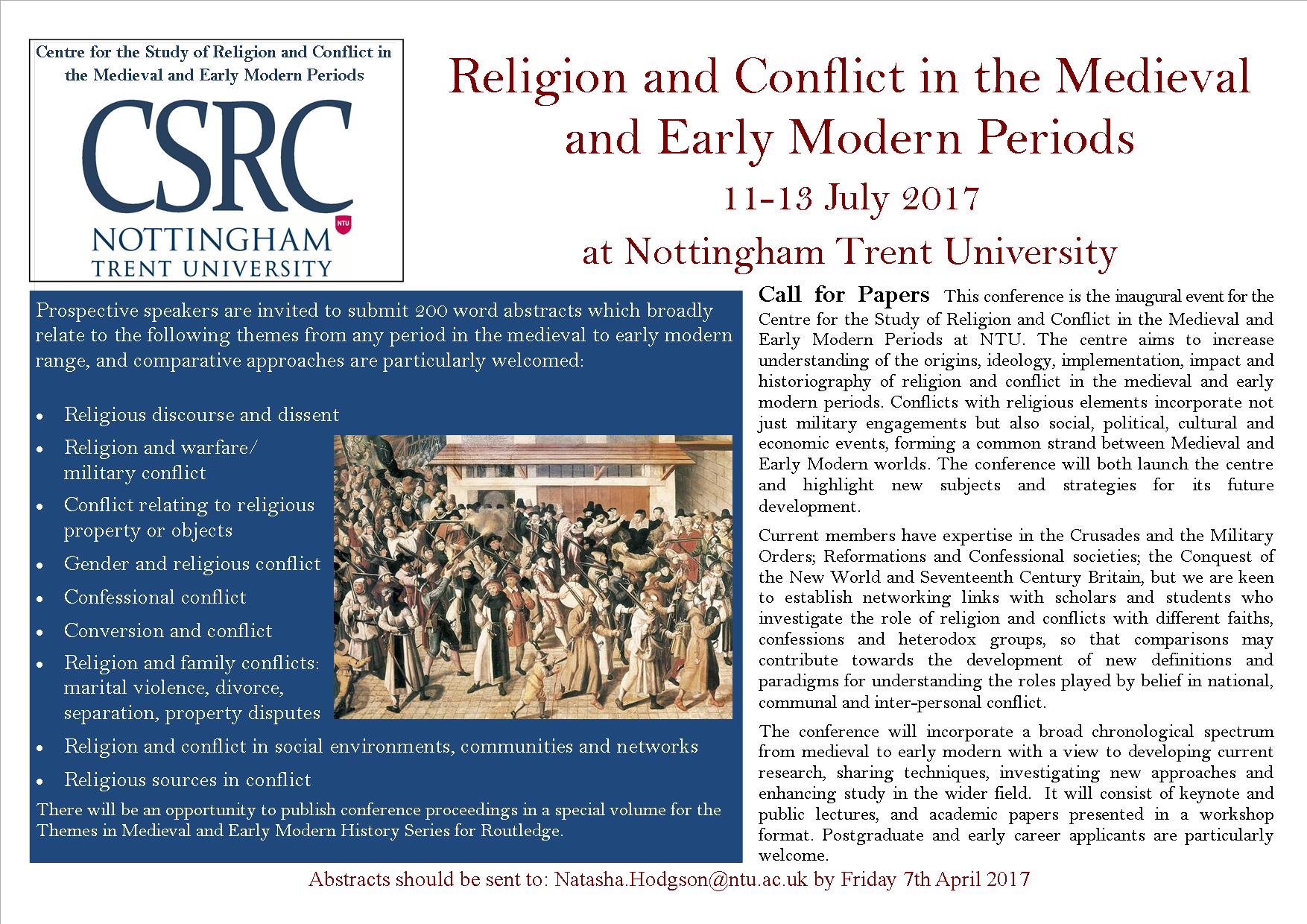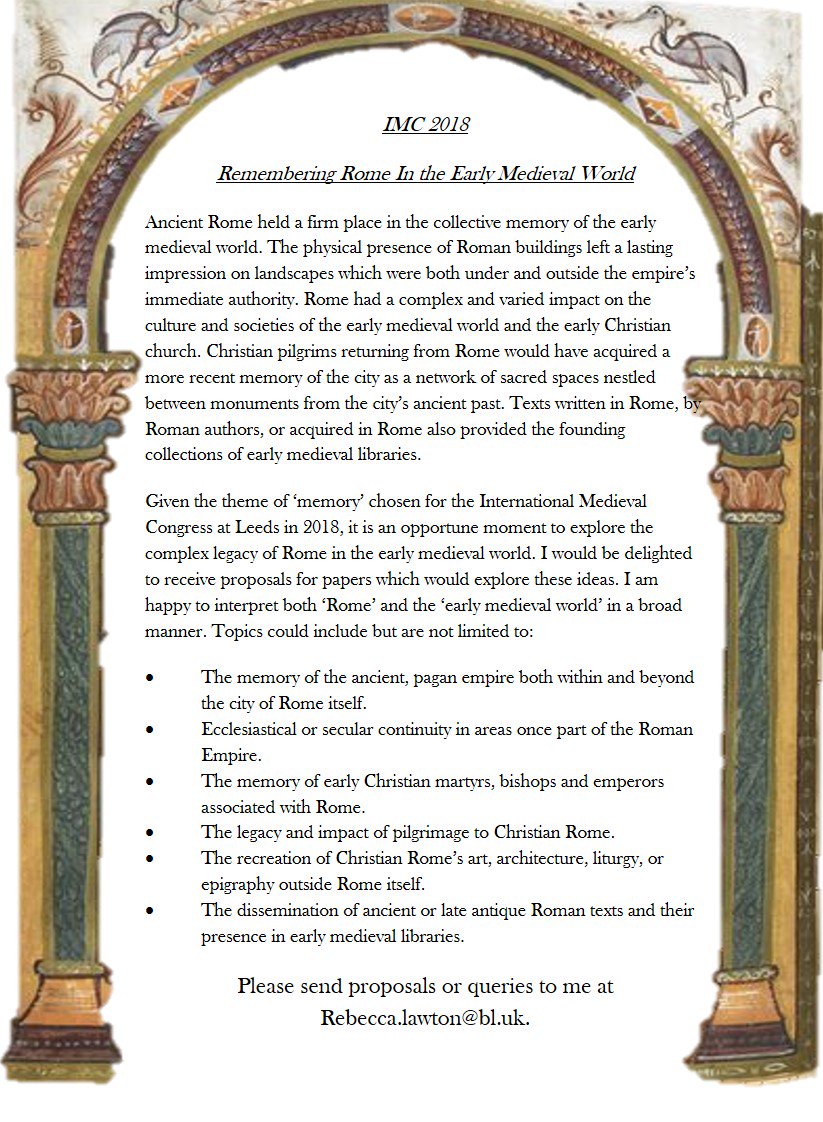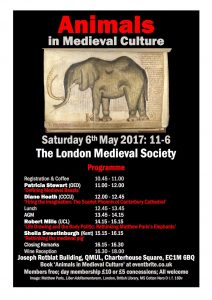Category Archives: Conferences/CFPs
Conference: England in Europe (Thirteenth Century England XVII) Selwyn College, Cambridge (4th-6th September)
The Thirteenth Century England Conference, which brings together scholars on all areas of English (and latterly British) history, has been running every two years for thirty years. In 2015 the Conference moved from Aberystwyth to Cambridge, and we are based here again for the XVIIth edition in September 2017. TCE represents the largest forum devoted specifically to work on the Long Thirteenth Century and has over the years served to introduce many new scholars and new scholarship to those working on the period.
The theme in 2017 is ‘England in Europe’.
The aim is to explore the complex and multifaceted, not to mention highly topical, relationship between the British Isles and their continental contexts. The conference will be an opportunity to reflect on the extent to which recent scholarship on England and its British neighbours in the long thirteenth century has been shaped up by considerations of Britain’s place in Europe but also by wider trends in the history of medieval Europe. The focus of the conference remains very much on fostering collaborative scholarship, introducing and encouraging emerging historians of the period, and hearing about new research.
The venue is Selwyn College, and residential accommodation is on offer to delegates who wish to stay in Cambridge across the three days. The conference organizers are Julie Barrau, Chris Briggs, Caroline Burt, Andrew Spencer and Carl Watkins If you have an enquiry about the conference, please contact Julie Barrau (jb534@cam.ac.uk).
Conference: Chronic Pain in the Middle Ages (29/9/17)
‘Why is my pain perpetual?’ (Jer 15:18): Chronic Pain in the Middle Ages
Start: Sep 29, 2017 09:00 AM
End: Sep 29, 2017 07:00 PM
Location: IAS Common Ground, Ground Floor, South Wing, Wilkins Building, UCL
Pain is a universal human experience. We have all hurt at some point, felt that inescapable sensory challenge to our physical equanimity, our health and well-being compromised. Typically, our agonies are fleeting. For some, however, suffering becomes an artefact of everyday living: our pain becomes ‘chronic’. Chronic pain is persistent, usually lasting for three months or more, does not respond well to analgesia, and does not improve after the usual healing period of any injury.
Following Elaine Scarry’s (1985) seminal work The Body in Pain, researchers from various humanities disciplines have productively studied pain as a physical phenomenon with wide-ranging emotional and socio-cultural effects. Medievalists have also analysed acute pain, elucidating a specifically medieval construction of physical distress. In almost all such scholarship – modern and medieval – chronic pain has been overlooked.
The new field of medieval disability studies has also neglected chronic pain as a primary object of study. Instead, disability scholars in the main focus on ‘visible’ and ‘mainstream’ disabilities, such as blindness, paralysis, and birth defects. Indeed, disability historian Beth Linker argued in 2013 that ‘[m]ore historical attention should be paid to the unhealthy disabled’, including those in chronic pain (‘On the Borderland’, 526). This conference seeks specifically to pay ‘historical attention’ to chronic pain in the medieval era. It brings together researchers from across disciplines working on chronic pain, functioning as a collaborative space for medievalists to enter into much-needed conversations on this highly overlooked area of scholarship.
Relevant topics for this conference include:
-Medieval conceptions and theories of chronic pain, as witnessed by scientific, medical, and theological works
-Paradigms of chronic pain developed in modern scholarship – and what medievalists can learn from, and contribute to, them -Comparative analyses of chronic pain in religious versus secular narratives -Recognition or rejection of chronic pain as an affirmative subjective identity -Chronic pain and/as disability -The potential share-ability of pain in medieval narratives, such as texts which show an individual taking on the pain of another -The relationship between affect and the severity, understanding, and experience of pain -The manner in which gender impacts the experience, expression, and management of an individual’s chronic pain
Keynote address:
-Prof Esther Cohen (Hebrew University of Jerusalem), one of the foremost scholars on pain in the Middle Ages, will deliver the keynote address: ‘What is Chronic Pain in a Non-Neural Age? Working Definitions, Sources, and Methodologies’.
Confirmed speakers:
-Dr Katherine Harvey (Birkbeck, University of London, UK), ‘Chronic Pain and the Saintly Bishop in Medieval England’
-Dr James McKinstry (Durham University, UK), ‘Headaches, Diseases, and Old Age: William Dunbar’s Diagnosis of Chronic Pain’
-Dr Michele Moatt (National Trust and Lancaster University, UK), ‘Chronic Pain and Prophecy in the Twelfth-century Life of Aelred of Rievaulx’
-Catherine Coffey (Queen’s University, Belfast, Northern Ireland), ‘“Mit zwoelf tugenden stritet si wider das vleisch”: The Body Fighting the Flesh in Mechthild von Magdeburg’s Das fließende Licht der Gottheit’
-Katherine Briant (Fordham University, New York, USA), ‘Pain as a Theological Framework in Julian of Norwich’s Vision and Revelation’
-Dr Nicole Nyffenegger (Bern University, Switzerland), ‘Mary’s Perpetual Physical Pain: Affective Piety and “Doubling”’
-Prof Wendy J Turner (Augusta University, Georgia, USA), ‘Mental Complications of Pain: Age and Violence in Medieval England’
-Dr Bianca Frohne (University of Bremen, Germany), ‘Living With Pain: Constructions of a Corporeal Experience in Early and High Medieval Miracle Accounts’
-Dr William Maclehose (University College London, UK), ‘A Locus for Healing: Saints’ Shrines and Representations of Chronic Pain’
For more information, visit http://www.ucl.ac.uk/institute-of-advanced-studies/ias-events/why_is_my_pain_perpetual_chronic_pain_in_the_middle_ages
Conference: Animals in Medieval Culture (6/5/17)
CFP: Gender, Identity, Iconography (4/9/17)
A Gender and Medieval Studies Group and Society for Medieval Feminist Scholarship joint conference.
Corpus Christi College, University of Oxford
8th-10th January 2018
The glittering beauty of the Alfred Jewel, the rich illustration of the Lindisfarne Gospels, the dominating Great West Window of York Minster, the intricate embroidery of the Bayeux Tapestry, the luminous Maestà of Duccio, the opulent Oseberg ship burial, and the sophisticated imagery of the Ruthwell cross are all testament to the centrality of the visual to our understanding of a range of medieval cultures.
Constructed at and across the intersections of race, disability, sexual orientation, religion, national identity, age, social class, and economic status, gendered medieval identities are multiple, mobile, and multivalent. Iconography – both religious and secular – plays a key role in the representation of such multifaceted identities. But visual symbols do not merely represent personhood. Across the range of medieval media, visual symbolism is used actively to produce, inscribe, and express the gendered identities of both individuals and groups.
The 2018 Gender and Medieval Studies Conference welcomes papers on all aspects of gender, identity and iconography from those working on medieval subjects in any discipline.
Papers may address, but are not limited to:
Sight and Blindness
Visible and Invisible Identities
Visual Languages
Colour and Shade
Icons and Iconoclasm
Light and Darkness
Collective and Individual Identities
Orthodox and Heretical imagery
Aesthetics
Subject and Motif
Convention and Innovation
We invite proposals for 20-minute papers. Please email proposals of approx. 200 words to gmsconference2018@gmail.com by Monday 4 September 2017. We will also consider proposals for alternative kinds of presentation, including full panel proposals, performance and art; please contact the organisers to discuss.
A conference for everyone
Corpus Christi College’s auditorium is fully wheelchair accessible, has accessible toilets, and features a hearing loop for those using hearing aids. Please contact us if you have specific accessibility needs you would like to discuss. We plan to provide a private lactation space.
It is hoped that the Kate Westoby Fund will be able to offer a modest contribution towards (but not the full costs of) as many postgraduate student travel expenses as possible. We are exploring other avenues to make the conference financially feasible for postgraduates and early career scholars to attend.
CFP: Religion and Conflict in the Medieval and Early Modern Periods (7/4/17)

CFP: Bodies in Motion in the Early Modern World (31/3/17)

Conference: Manuscript after Print (6th-7th April)
International Conference
Austrian Academy of Sciences
Vienna, 6th–7th April 2017
Thirteen international speakers will analyse the simultaneity of the handwritten and printed media in post-medieval Iceland, Ireland and Great Britain. The aim of the conference is to analyse post-medieval manuscript culture systematically, to bring specialists from different fields who work on similar subject together, and to open up ways for future collaborations.
Johannes Gutenberg’s invention of the printing press in or around 1450 brought about radical changes in communicative media. Printing proved to be extraordinarily influential, and within a few decades the printing press and printed books were to be found in all major European cities. Several studies emphasise this revolutionary aspects of Gutenberg‘s invention the printing press and label it as the key element of the transition from the Middle Ages to modern times: the printed word enabled, changed, enlarged and disseminated knowledge to a public audience for the first time in Europe. Thus, print enabled speedy and effective communication of new ideas of the Renaissance, the Reformation and advances in science.
Recent studies, however, prefer to portray the media change as a slow and developmental process: rather like an evolution than a revolution. Manuscript production did not cease after the invention of the printing press and contemporaries conceived no difference of media between books and manuscripts. In Iceland manuscript production increased considerably in post-medieval times. From the c. 20,000 extant Icelandic manuscripts world-wide, only c. 750 were written before the Reformation. In Ireland, where the manuscript tradition bears striking similarities to that of Iceland, around 80% of extant manuscripts were written in the 1650-1850 period.
It was not just the invention of the printing press that led to changes, though. Several factors played an important role in the development of the written word, such as the introduction of paper to the Western world and rising standards of education and literacy.
In this conference we will analyse three factors that were significant for the specific developments of print and manuscript culture: media, material aspects, and gender and social norms. Regarding media, speakers will analyse how oral, written and visual elements define the specific textuality of books and manuscripts, and what influence print had on post-medieval manuscripts. Concerning material, the introduction of paper to the Irish scribal market will be analysed. The third factor, social norms and gender, will focus on the possibilities of publication with regard to gender and literary genres, the implications of the chosen medium, and what types of texts were selected from print culture to reproduce in handwriting.
Programme
Poster
CFP ‘Storytelling’ (31st March)
This year, the theme of the Centre for Medieval Studies’ Graduate Conference is ‘Storytelling‘. Storytelling is a fundamentally human activity that bridges the past and present, the local and the international. Stories can be told through many mediums: art,
stained glass, buildings, manuscripts and oral accounts can all transmit stories,
whether they were intended to or not.
This is an interdisciplinary conference and we encourage papers from all disciplines including History, Literature, Art History, Archaeology, Classics, Philosophy and Paleography. Papers may consider, but are not limited to, the following topics:
- Writing the past: history in the medieval period
- Concepts of truth and fiction
- Memory and interpretation: competing stories (medieval and methodological)
- Metatexts: annotation, illustration and compilation
- Re-telling stories: transmission, translation, and changing perspectives
- The interaction between orality and literacy
- Spatial storytelling: the experience of stories through architecture
The deadline for submissions is 31st March 2017. Please submit abstracts of no more than 300 words along with a short biographical note to cms-grad-conf@york.ac.uk
Conference: The Study of the Bible in the Middle Ages, Saturday 18th February
The Study of the Bible in the Middle Ages: Where are we now?
The Study of the Bible in the Middle Ages is a conference aimed at bringing together academics at all stages of their careers to discuss the legacy of Beryl Smalley and her influence across the disciplines of medieval history, theology and politics.
Conference programme: https://studyofthebible.wordpress.com/conference-programme/
Registration: https://www.eventbrite.com/e/the-study-of-the-bible-in-the-middle-ages-tickets-30050471770

